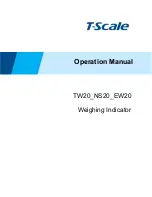
120
The storage capacity according to the programmable integration time are in the following
table.
Storage capacity
T= 1 s
Î
1 month 3 days
T= 1 min
Î
11 months 7 days
The storage times for each type of recording correspond to one single recording, until the
memory is completely full.
The SC310 has enough capacity for up to 1000 registers (final results or recordings) of any
kind.
When the built-in memory is full, no more recordings can be made and no more final results
saved. If you attempt to do this, the 'MEMORY FULL' message will appear on screen. If the
memory reaches its maximum capacity before a recording has finished and the CIRCULAR
MEMORY option is not activated (see 9.6), data recording will stop, although measurement
will continue. When the measurement is stopped, the final result will be stored in the
memory.
9.6 Circular memory
The SC310 allows you to configure the empty memory space as a circular data-storage
buffer. That is, when you select the SETTINGS
Î
è
RECORDING
Î
è
CIRCULAR MEMORY
option from the menu the empty memory space will be configured as a circular buffer, while
the already occupied memory space remains unaffected. This means that as from this
moment onwards, when you begin a recording, the SC310 will save data until its memory is
full. When this moment comes, it will continue to save data, though deleting the oldest data
stored in the memory space prior to beginning the recording. This space will always contain
the latest data measured.
This quality, together with the feature of downloading data while recording or when
measurement is in progress, allows you to have a neverending memory at your disposal, if
you periodically download stored data.
9.7 View the register
This option allows you to display on screen the final result of the registers stored in the
SC310 memory. Access the option by selecting MEMORY
Î
VIEW REGISTER from the
SC310 menu.
By pressing
,
and
, the SC310 allows you to select the register you
want to view. The screen will display an index of all the registers stored in the memory
(register date and time when the measurement process began).
To view the different functions, follow the procedure described in sections 9.4.3.
















































